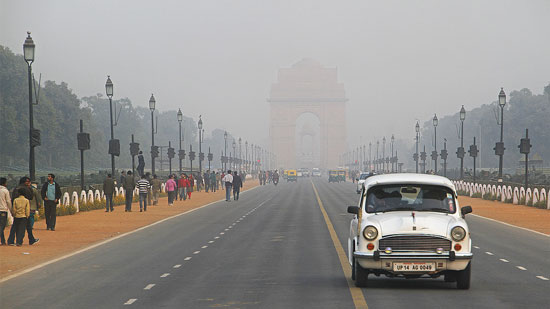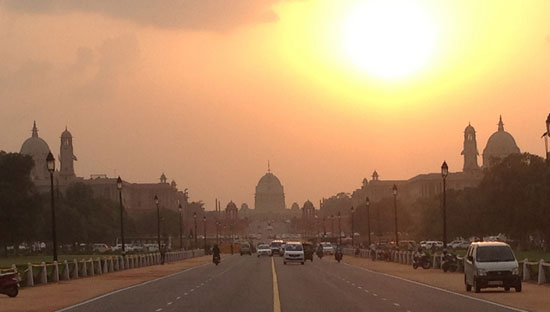

“Driving is a comfortable and leisurely way to travel between…cities in India. It gives you the opportunity to do the trip at your own pace.”
—From a current guidebook
The highway out of Delhi looks like it has a rash. What is this stuff? It’s smashed-up watermelons from a truck.
I realize I am going to die here, along with all this fruit, when I notice that my driver hasn’t slowed. Ahead on the left is the wreck of the melon truck. I can see the Indian make, TATA, on its colorful bumper and the instruction, “Please Blow Horn.” Too late for that.
To our right is a steamroller rolling the wrong way. Straight in front we are about to demolish three old men on a bicycle, a cart being tugged by a camel, a homemade tractor, and–I can watch their flicking tails up close–a herd of calico goats.
There is no explosion. No pain. Just a puff of orange dust.
My first view of the afterlife is a sign for a brand new tourist hotel. ON YOUR WAY TO JAIPUR, it suggests, VISIT THE JUNGLE BABBLER RESORT.
Besides the Jungle Babbler, heaven includes India’s National Highway Number 8, my guide Kumar Nirala and our driver, Manuel. Or maybe, by some miracle, we have slalomed safely through all these vehicles and animals and are still alive.
Manual, a South Indian with a Spanish name, reaches for the rearview mirror and jangles a little decorative bell.
“What’s that for?” I ask, wiping my brow.
“He is saying thanks,” replies Kumar. “In India, you see, a good driver depend on three things. Good horn. Good brake. And good luck.”
* * *
I have come to India not to bounce in the backseat of an “Indigo” sub-compact sedan. The idea was to visit once-in-a-lifetime sights like the Taj Mahal and the pink stone city of Jaipur.
I am on my way I keep reminding myself, but National Highway Number 8 has its own ideas about the pace of my trip. It is early summer. No rains yet but in the heavy air there is a hint of monsoon.
“Today,” announces Kumar from up front, “the temperature in Centigrade is 44 degrees.” I do a quick calculation and come up with 111. That can’t be right. Can it? Everything that’s black in the car–door handles, the dashboard, locks–feels like smoldering coal. And when I accidentally touch my metal belt buckle that’s been in a patch of sun, I yelp.
Highway Number 8 is supposed to be a major turnpike, but we whiz past vendors hawking fruit, ice cream, juice squeezed out of stacks of sugar cane, and–according to the sign on one miniature stand–“Refrigerated Water.” Boys waving bags of snacks charge at the car trying to get Manuel to pull over.
As usual the Indigo does not break stride. The houses we pass are the color of candy cigarettes. Pinks, bleached whites, baked browns, brick reds. A Hindu temple looks like it’s on fire, but I realize what I’m watching are waves of pure heat rising from the tiled roof.
Soon we have to dodge around earthquake-deep cracks in the asphalt. Now there are alpine ravines and volcano holes. I am happy to see a work crew filling these up. One man is doing the detail work, pouring tar from a porcelain teapot.
Seeing a bicycle cart reminds me of Delhi, the day after I arrived. Kumar and I had flagged down a rickshaw for a ride through the Old City. Delhi rickshaws are pedaled, not pulled, and this one featured a high and ornate bench welded to the back of an Indian-made “Hero”-brand bike.
Power was provided by Ahmed Sayid, a man in large pajamas who hummed as he rode. In the spaghetti streets of Kinari Bazaar, Sayid was less lucky than the bell-ringing Manuel. Calling out, “Chalo, chalo,” (“go, go”) Sayid ran over the heel of a woman in the crowd and near the end of the tour, rammed us into the flank of another rickshaw.
There is a screech of brakes. A thundercloud of dust. The Indigo has swerved away from something. I swivel my head to see a turbaned man waving his fists.
Manuel taps his bell. “It is this man’s fault,” explains Kumar. “He is running across. Pedestrian is supposed to walk slowly. If they run, you allowed to hit them.”
“That can’t be true,” I say.
“Oh yes, oh yes,” replies Kumar.
A versatile and clever guide, Kumar is armed with two key phrases that he can use in almost any situation:
- “Oh yes, oh yes.”
- “No, it is not like that.”
I get the second one, “it is not like that,” if I suggest something even slightly negative about India. I hear the first if I am skeptical. Just to test this, I ask Kumar at one point if India has a space program. There isn’t a second’s hesitation. “Yes,” says Kumar proudly. “Oh, yes.”

In the U.S. there are many furtive liars. Indians lie happily and with delight. But Kumar, I believe, is, at heart, an honest man. Now and then he may exaggerate a bit, but not any more than I do and with a great deal more style.
Here are some other Rules of the Indian Road, according to my guide and to what I can see from the rear seat of the Indigo:
* Right of Way: If you can get your bike or goat in front of someone else’s, you’ve got right of way.
* Staying in Lane: Don’t bother, no one else does.
* Using the Horn: Rather than thinking it’s rude, other drivers urge you to blow it. (Otherwise they won’t know you’re there.)
* Passing: Go for it. Like the British, Indians drive on the left. But you’re expected to pass on both sides and to use shoulders and medians when possible.
* Turn Signals: What?
Arriving in Jaipur, I can see it is as pink a city as the guidebooks say. Some of the sunrise color of walls and buildings is stone, and some of it is paint.
As Manuel pilots the Indigo around town, we get stuck in market crowds and here and there pull over for sights or shops. The main boulevards of Jaipur are designed for easy traffic flow except for two things: temples that are strategically placed smack in the center of the road, and mammoth trees that have grown through the asphalt, blocking one or both lanes.
When I ask Kumar about these he seems surprised. “Of course,” he says, “you understand that these trees, these temples, are very old. They cannot be chopped down.”
“What if a bus hits one?” I ask.
“No,” says Kumar, “this never happen.”
In truth, I am glad about the old trees and temples. The next morning we circle around more of them until, at a cobblestone square beneath the famous Amber Fort, we switch to an elephant for our ride to the ramparts and gardens up above.
There are only fifty elephants available here, which seems more than enough to me. But since Kumar expressed concern, we arrive just as the sun starts to show over the ragged hills that protect this ancient citadel.
Kumar and I share space on a rug that has been spread out along the back of Rani–a very calm elephant with freckled pink ears. Rani’s handler, Mohammed Islam, wears a rainbow turban and sits in front.
Unlike the Indigo, Rani doesn’t bounce. She sways. Soon I am trying to get with the rhythm, rolling a little, slipping a lot, and staring down at dizzying vistas of the lakes below.
Rani, I am told, means “Queen.” And marching with her through the gates of the Amber Fort makes me feel like a conqueror. Like a prince or king. I raise my arms. I silently command that all other tourists bow down. But it’s the giant elephant feet of Rani–boom, boom, boom–that do the job.
“Oh, yes. Oh, yes,” says Kumar, seeing the path open up before us, watching walkers and bikers scramble to the side.
Still there is something missing. I miss the roar and screech of the Indigo. I miss Manuel.
Then I see something silvery sewn onto one of Rani’s decorative cloths. When Mohammed Islam isn’t looking I reach over.
I am feeling powerful. Feeling mighty.
Feeling lucky.
I tap the bell.
Peter Mandel is an author of books for children including Jackhammer Sam (Macmillan) and Zoo Ah-Choooo (Holiday House). He lives in Providence.
